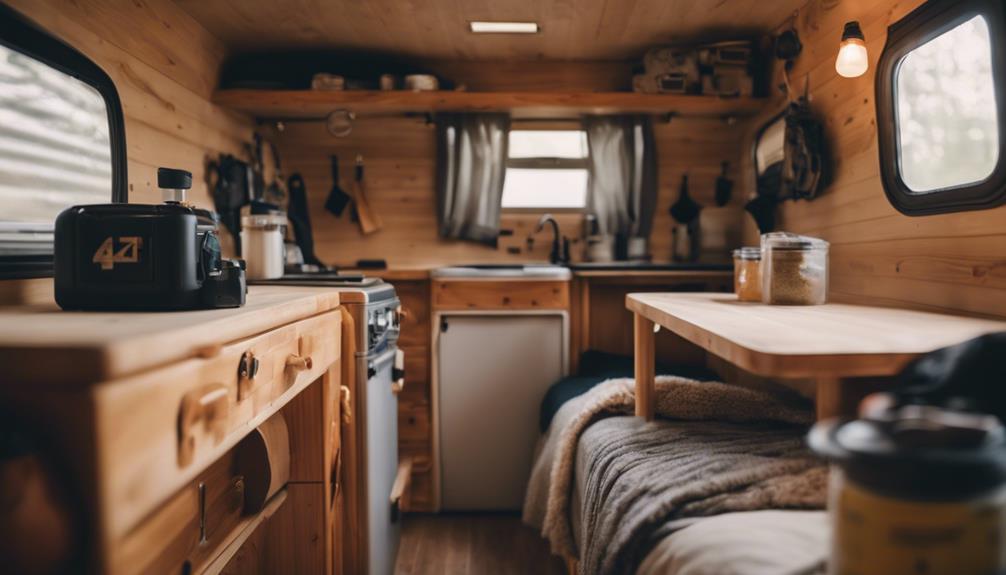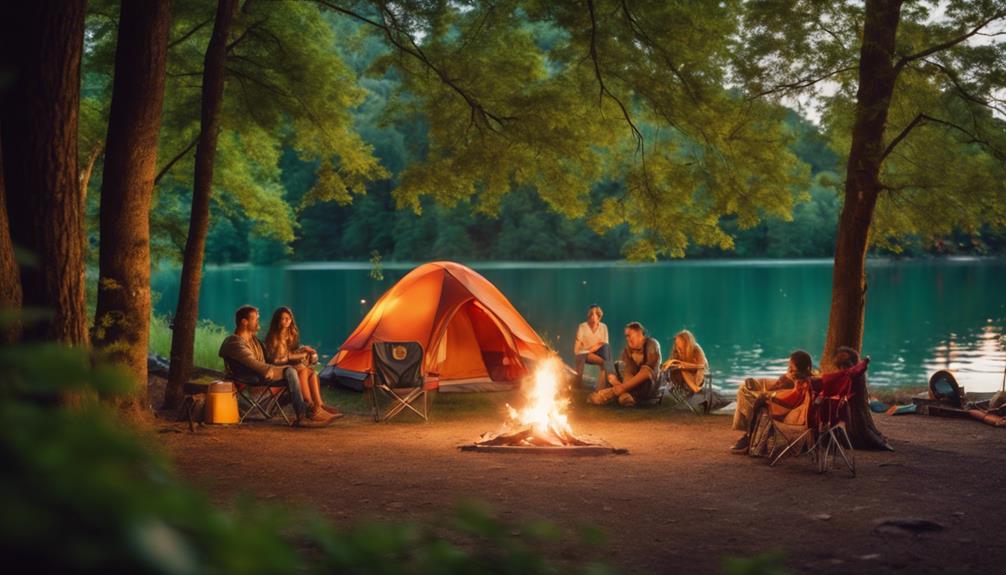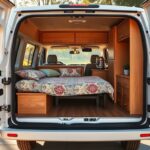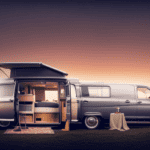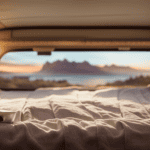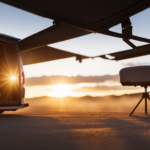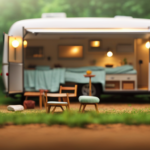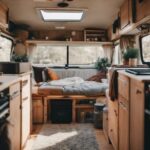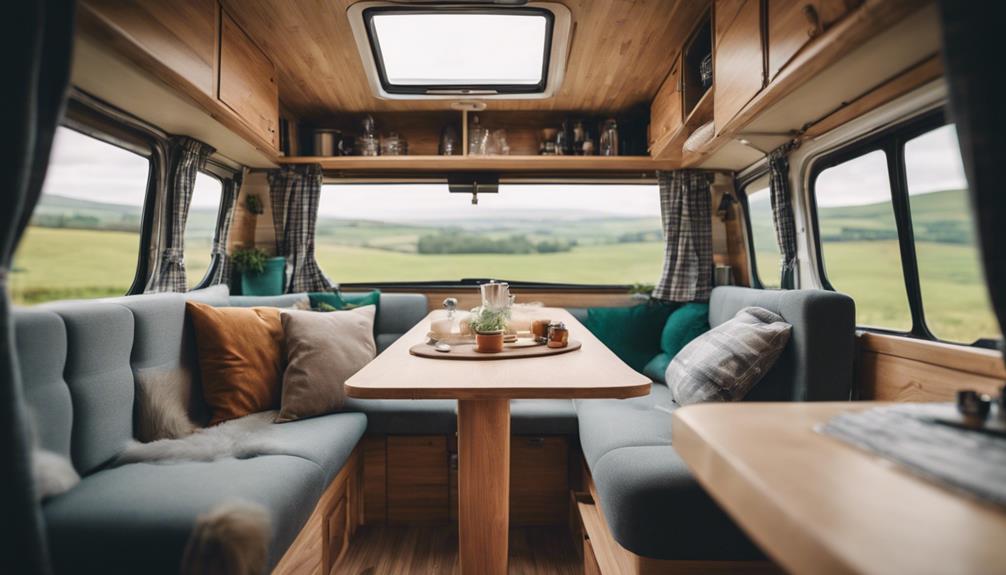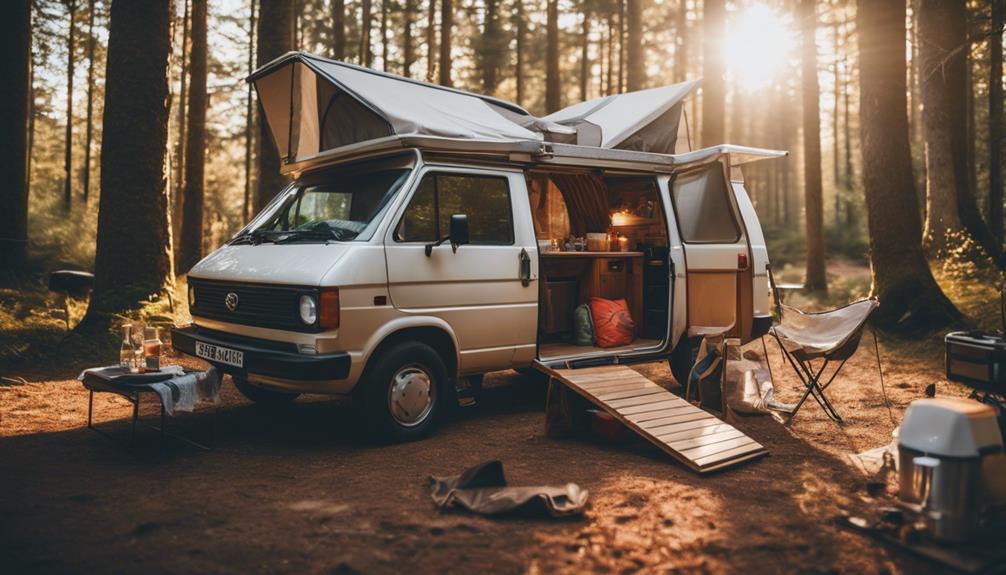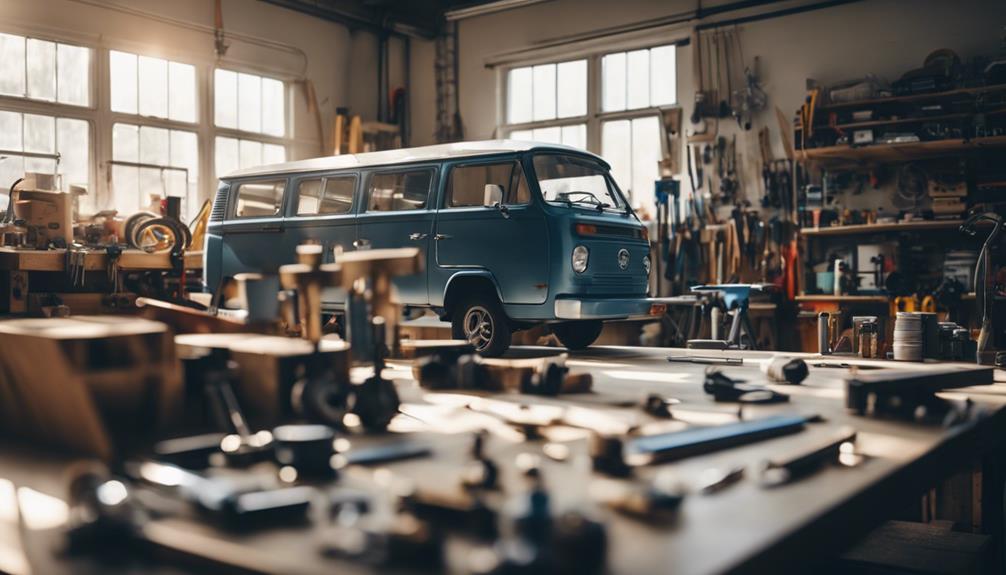When converting a camper, you'll need essential supplies to get started. First, gather tools like a cordless drill, measuring tape, and a utility knife. For insulation, consider foam board or fiberglass batts. You'll also need electrical components, such as deep cycle batteries, inverters, and LED lights. Plumbing supplies like water tanks and pumps are vital for setup too. Finally, think about furniture—beds, tables, and storage solutions will maximize your space. These basics will set the foundation for your project, but there's plenty more to explore as you plan your conversion journey.
Introduction
Converting a camper into a cozy living space requires careful planning and the right supplies to guarantee a successful transformation. When you're tackling a camper van conversion, it's vital to gather a variety of tools and materials beforehand to streamline the process. You'll need fundamental tools like a cordless drill or screwdriver, measuring tape, and a level tool to make sure everything fits perfectly and is installed securely.
Insulation materials are key for maintaining a comfortable temperature inside your camper van. Foam board and fiberglass batts can help create a cozy environment regardless of the weather outside.
Don't forget about electrical components; deep cycle batteries, solar panels, and inverters are critical for powering lights and appliances efficiently.
Plumbing essentials also play a significant role in your camper's functionality. Water tanks, pumps, and sinks will provide you with fresh water and help manage waste.
Background Information
In 2020, campervans skyrocketed in popularity, inspiring many to take on DIY conversion projects.
You might've noticed friends or influencers sharing their camper journeys, sparking your interest in creating your own mobile getaway.
Understanding the essentials will help you transform a simple van into a cozy travel haven.
Campervan Popularity Surge in 2020
The COVID-19 pandemic sparked a remarkable surge in campervan popularity, as people sought safe and flexible travel options during uncertain times. With outdoor activities on the rise, many turned to van conversion as an appealing solution for vacations that allowed for social distancing. Online searches for campervans and DIY conversion resources skyrocketed by over 400% in 2020, showing just how enthusiastic folks were to embrace mobile living.
The campervan rental market saw a staggering 70% increase in bookings during the summer of 2020, which highlights this growing trend. As remote work became the norm, you likely found yourself considering the benefits of a flexible lifestyle. Campervans provided the perfect balance between work and adventure, allowing you to hit the road while still meeting professional commitments.
Social media played an essential role in fueling this interest. Platforms showcased inspiring van life experiences, motivating many to undertake their own van conversion projects. With this newfound enthusiasm for campervans, it's clear that the pandemic reshaped how we view travel and living arrangements, paving the way for a lasting appreciation of life on the road.
Increased DIY Campervan Projects
As more people embrace the freedom of traveling in personalized spaces, DIY campervan projects have become increasingly popular, offering an affordable way to create unique living environments on the road.
The COVID-19 pandemic has sparked a surge in interest, with over 50% of new RV owners expressing a desire to convert vans into functional living spaces. This trend allows you to tailor your camper van to fit your travel style, whether you prefer minimalist designs or fully-equipped mobile homes.
The rise of online communities has made it easier than ever to find inspiration and resources for your project. Platforms like YouTube and Instagram are filled with successful DIY campervan transformations, providing you with tips and tricks to enhance your own conversion. Additionally, the demand for campervan conversion kits has skyrocketed, driving growth in related businesses.
On average, a DIY campervan conversion can cost between $5,000 and $30,000, depending on the materials and features you choose. This affordability encourages many to take on these projects themselves, ensuring their camper vans reflect personal tastes while maximizing comfort and functionality on the road.
Emerging Campervan Design Trends
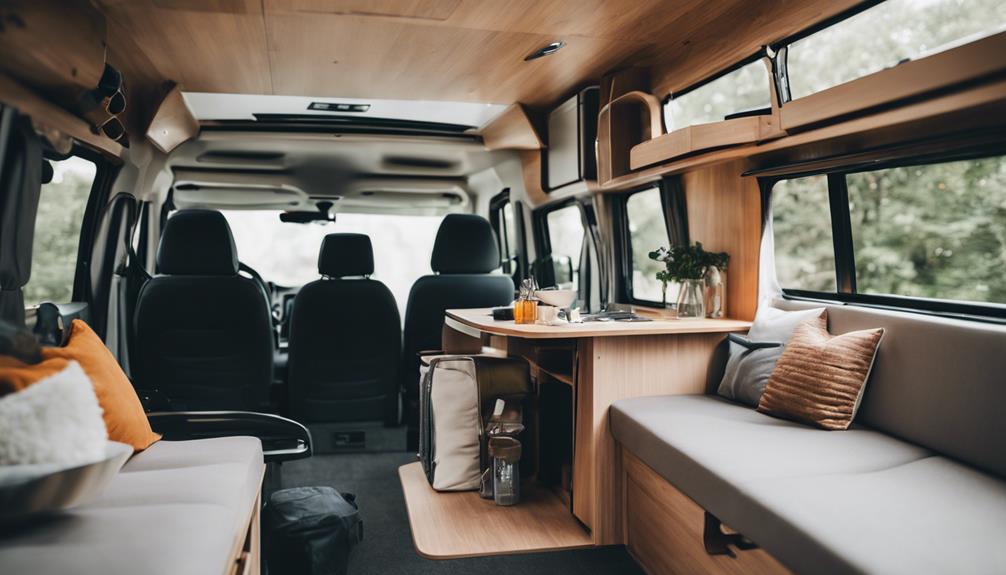
As you explore emerging campervan design trends, you'll notice a strong shift towards sustainable materials that help reduce your environmental footprint.
Innovative storage solutions are also becoming key, allowing you to maximize space without sacrificing comfort.
These trends not only enhance your van's functionality but also align with a growing desire for eco-conscious living.
Sustainable Materials in Design
Sustainable materials are transforming campervan design, making it easier than ever to create eco-friendly living spaces that minimize environmental impact. You can choose materials like bamboo and reclaimed wood for their durability and environmentally friendly qualities, as they utilize resources that would otherwise go to waste.
Biodegradable insulation options, such as cellulose and cotton, are also gaining traction due to their thermal efficiency and lower carbon footprint compared to traditional fiberglass.
When designing your camper, consider using eco-friendly composite materials made from recycled plastics and natural fibers. These lightweight yet strong alternatives are perfect for cabinetry and furniture, enhancing both functionality and sustainability.
Additionally, low-VOC (volatile organic compounds) paints and finishes are becoming standard in modern designs, promoting healthier indoor air quality while reducing harmful chemical emissions.
Innovative Storage Solutions
Eco-friendly designs aren't just about materials; they also embrace innovative storage solutions that maximize space and enhance functionality in camper vans.
When planning your van build, consider modular designs that adapt to your unique needs, making it easy to customize configurations. Multi-functional furniture, like beds with built-in drawers or foldable tables, has become popular for optimizing storage while ensuring usability in tight spaces.
You can also take advantage of vertical storage options, such as wall-mounted shelves and hanging organizers. These solutions help you utilize underused wall space while keeping essential items easily accessible, minimizing floor clutter.
Additionally, clever under-bed storage compartments and hidden spaces within cabinetry greatly boost your camper's overall storage capacity, allowing you to bring more belongings without compromising on comfort.
Emerging trends further highlight the integration of technology in storage solutions. App-controlled systems enable you to organize and monitor your camper contents remotely, streamlining space management like never before.
With these innovative storage solutions, you'll maximize your camper's potential and enjoy a more organized, functional living space on your adventures.
Cost-Benefit Considerations
When planning your camper conversion, you'll want to weigh cost against convenience carefully.
Understanding industry expert insights can help you make informed decisions, and evaluating cost versus quality guarantees you're getting the best bang for your buck.
Let's explore these critical considerations to maximize your investment.
Cost Versus Convenience Analysis
Balancing the upfront costs of camper conversion supplies with their long-term benefits can greatly impact your overall experience and savings. When conducting a cost versus convenience analysis, consider how initial investments can yield considerable returns.
For instance, spending on high-quality insulation might seem steep, but it can reduce your energy costs by up to 40%, making it a smart choice for comfort and savings.
Similarly, while energy-efficient appliances like LED lights and a Dometic powered cooler may cost more upfront, they can save you over $200 annually on energy bills. Investing in a solar panel system also appears costly, ranging from $1,000 to $3,000; however, it can pay for itself through energy savings in just 5-7 years, offering you the freedom of off-grid living.
Don't overlook multi-functional furniture either. While it might be pricier, it maximizes space and minimizes the need for extra storage, saving you both time and money.
Industry Expert Insights
Industry experts agree that investing wisely in camper conversion supplies can lead to substantial long-term savings and enhanced functionality. One of the most important areas for investment is insulation materials. High-quality insulation can maintain comfortable temperatures and reduce heating and cooling costs by up to 30%. This means you'll save money on energy bills over time, making your initial investment worthwhile.
Additionally, when you choose the right electrical components, like deep cycle batteries and solar panels, you're not just enhancing your off-grid capabilities; you're also decreasing reliance on expensive fuel sources. You could save around $100 monthly on energy costs.
Multi-functional furniture is another smart choice. Although it may come with a higher upfront price, it maximizes your space efficiency and prevents the need for buying extra furniture.
Furthermore, proper plumbing systems are essential. Investing in efficient water pumps and tanks can save you from costly repairs, as improper installations can lead to thousands in damages.
Cost Versus Quality Evaluation
Evaluating cost versus quality in camper conversion supplies is essential for making smart investments that guarantee durability and efficiency.
While it might be tempting to opt for cheaper materials, consider the long-term implications. Investing in higher-quality items, like lithium batteries, often leads to longer lifespans and improved energy efficiency, saving you money on replacements over time.
When you choose durable insulation materials, such as foam board or reflective insulation, you might face a higher upfront cost, but the long-term savings on heating and cooling bills can be significant.
Reliable electrical components, like deep cycle batteries and quality inverters, may demand a larger initial investment, yet they provide a stable power supply, reducing the risk of costly system failures.
Even for furniture and fixtures, consider multi-functional and sturdy designs. While budget options seem appealing, they often lead to frequent replacements, negating any initial savings.
Finally, investing in a high-quality plumbing system, including dependable water pumps and tanks, can prevent leaks and maintenance issues, saving you from expensive repairs and water damage.
Ultimately, weighing cost versus quality will lead to a more efficient and cost-effective camper conversion.
Essential Safety Precautions
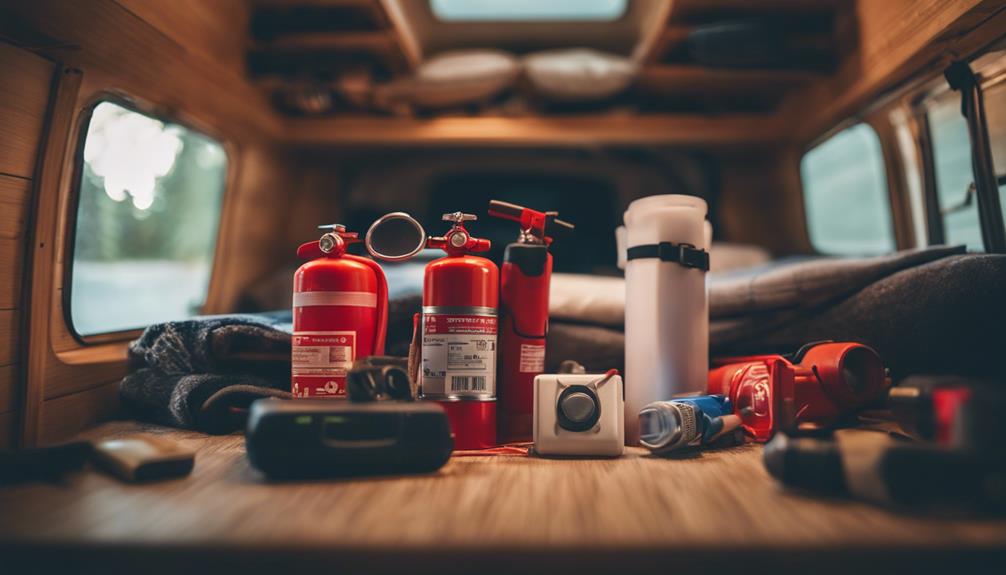
When you're converting your camper, prioritizing safety is vital.
You should create an all-encompassing safety checklist and invest in essential safety gear to protect yourself and your loved ones while on the road.
Let's explore the key items you need to guarantee a safe camping experience.
Safety Checklist for Conversions
A thorough safety checklist is vital to confirm your camper conversion is both comfortable and secure for all occupants.
First, make certain you have a fire extinguisher within easy reach. A minimum size of 2.5 lbs is recommended for effective emergency response. Next, install smoke and carbon monoxide detectors in living areas to alert you to dangerous conditions; don't forget to check them regularly to verify they work.
When working with tools and materials, always wear proper safety goggles and gloves to protect your eyes and hands from injury. Accidents can happen, so keep a well-stocked first aid kit in the camper. Essential items include adhesive bandages, antiseptic wipes, and gauze for treating minor injuries on the road.
Lastly, regularly inspect all electrical components and wiring for wear or damage. This step is vital to prevent potential fire hazards and confirm the safe operation of appliances in your camper.
Safety Gear Recommendations
To guarantee your safety during the camper conversion process, investing in essential safety gear is critical for protecting yourself from potential hazards.
Start with safety goggles; they're fundamental when using power tools to shield your eyes from debris and splinters. Pair those with sturdy gloves to prevent hand injuries while handling materials or working on construction tasks.
Next, don't overlook the importance of a fully stocked first aid kit. This should include bandages, antiseptics, and any necessary medications for minor injuries or emergencies that may arise on the road.
You'll also need a fire extinguisher that's easily accessible and rated for Class B (flammable liquids) and Class C (electrical) fires. This guarantees you're prepared for common fire hazards in camper vans.
Lastly, install carbon monoxide detectors in sleeping areas and common spaces to alert you to dangerous gas levels, especially when using gas appliances.
Regular maintenance checks of all safety equipment are critical to confirm everything works effectively and meets safety regulations.
What Essential Supplies are Included in the Price Estimate for a Camper Conversion?
When it comes to camper conversion price estimates, it’s important to know what essential supplies are included. This may vary, but typical inclusions are insulation, electrical wiring, plumbing fixtures, and cabinetry. Be sure to clarify the inclusions with your converter to avoid any unexpected costs.
What essential supplies are needed for camper conversion in a compact camping solution?
When planning a camper conversion in a compact camping solution, it’s essential to choose the best cars for camper conversion. These include vehicles with ample space for storage and sleeping arrangements, such as vans or SUVs. Other essential supplies include a portable stove, water storage, and a comfortable mattress for a good night’s sleep.
Conclusion
Successful camper conversions hinge on having the right supplies, ensuring your adventure is both comfortable and safe. To achieve this, you'll need an extensive list of essential supplies that covers everything from insulation materials for thermal efficiency to electrical components like batteries and solar panels for power.
Don't overlook plumbing essentials for your water systems, as they're crucial for convenience on the road.
Interior furnishings, such as bed frames, storage solutions, and portable tables, play a huge role in maximizing comfort and functionality in your limited space. Safety equipment, including fire extinguishers and first aid kits, is also important for emergency preparedness during your travels.
Moreover, tools are indispensable throughout the conversion process. A cordless drill, measuring tape, and level tool will help you with accurate assembly and installation.
Frequently Asked Questions
What Do I Need for a Campervan Conversion?
For your campervan conversion, you'll need tools like a drill and saw, insulation materials for comfort, a solid electrical system, plumbing essentials for water management, and furnishings to maximize space and enhance your living experience.
What Accessories Do You Need for a Campervan?
For your campervan, you'll need practical accessories like insulated window covers, safety gear, and efficient storage solutions. Don't forget essential kitchen items, deep cycle batteries, and solar panels to keep your adventures powered and comfortable.
What Is Essential for a Campervan?
For your campervan, you'll need reliable insulation for comfort, a solid electrical system for power, functional furnishings for space efficiency, plumbing for daily needs, and safety gear to guarantee you're prepared for any situation.
What Does a Camper Need to Be Self Contained?
To be self-contained, you need a fresh water system, waste management, a reliable electrical setup, effective insulation, and smart storage solutions. These elements guarantee comfort, convenience, and functionality during your camping adventures.
Conclusion
In summary, a camper conversion can be an exciting adventure, but it's vital to have the right supplies and safety measures in place.
By staying informed on design trends and weighing the costs, you can create a comfortable and functional space that suits your needs.
Remember to prioritize safety throughout the process, ensuring a worry-free experience on the road.
So, gather your essentials, plan wisely, and get ready to hit the open road with confidence!

